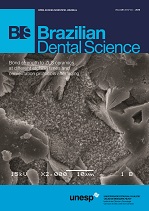Relationship of Oral Aesthetic Assessment according to Self Perception with Oral Malocclusion Condition of High School Students in Sidrap District, South Sulawesi Indonesia
DOI:
https://doi.org/10.14295/bds.2019.v22i4.1712Resumo
Self-perception of dental aesthetics needs to be considered in planning orthodontic treatment because it is known that everyone has a self-perception of different oral esthetic conditions. Objective: To assess the state of malocclusion based on self-perception of dental aesthetics using the Oral Aesthetic Subjective Impact Score (OASIS); to determine the relationship of self-perceptions of oral aesthetics and the state of malocclusion from the results of clinical examinations using the Dental Aesthetic Index (DAI). Material and Methods: Research subjects were middle school students aged between 14-18 years as many as 187 students. For oral aesthetic assessment using the OASIS index questionnaire, and to evaluate the aesthetic and anatomical components of the malocclusion clinic using the Dental Aesthetic Index (DAI). Results: The prevalence of malocclusion according to Dental Aesthetic Index (DAI) showed that mild / normal malocclusion (59.9%), moderate malocclusion (33.4%), severe malocclusion (5.7%), and very severe malocclusion (1%). The prevalence of self-perception of oral aesthetics was 54.6% judging good. The results of the analysis with logistic regression tests showed that there was a significant (p<0.001) relationship between self-perception of oral aesthetics using the OASIS index and malocclusion status using the DAI index. Conclusion: Based on the results of this study, there was a significant relationship (p <0.01) between oral aesthetic self perception and malocclusion status of high school students.
Keywords
Oral aesthetic perception; Oral aesthetic subjective impact score; Dental aesthetic index.
Downloads
Downloads
Arquivos adicionais
Publicado
Como Citar
Edição
Seção
Licença
TRANSFERÊNCIA DE DIREITOS AUTORAIS E DECLARAÇÃO DE RESPONSABILIDADE
Toda a propriedade de direitos autorais do artigo "____________________________________________________________________" é transferido do autor(es) para a CIÊNCIA ODONTOLÓGICA BRASILEIRA, no caso do trabalho ser publicado. O artigo não foi publicado em outro lugar e não foi submetido simultaneamente para publicação em outra revista.
Vimos por meio deste, atestar que trabalho é original e não apresenta dados manipulados, fraude ou plágio. Fizemos contribuição científica significativa para o estudo e estamos cientes dos dados apresentados e de acordo com a versão final do artigo. Assumimos total responsabilidade pelos aspectos éticos do estudo.
Este texto deve ser impresso e assinado por todos os autores. A versão digitalizada deverá ser apresentada como arquivo suplementar durante o processo de submissão.























